 Thanks: 0
 Likes: 0
 Dislikes: 0
-
New Flex PE14 - How to use ONLY a rotary buffer to finish out hologram free?
New Flex PE14 - How to use ONLY a rotary buffer to finish out hologram free?
Has anyone used the new flex PE14 yet? I just purchased one and was wondering what pad and product types work good on black minor swirl vehicles?
Also I want to be able to finish with this machine.
Is this something that can be achieved?
I'm fairly new to detailing.

-
Super Member

Re: New Flex PE14
It is a fantastic machine.
I have been using mine with my Lake country and 3M pads.
Of course you can finish with it! If you use a nice finish polish like Ultrafina SE or PO85RD, the paint will finish beautifully.
With the swirl marks, remember to always use the least aggressive product first. Depending on the swirls, and how deep they are, you can get away with using a light polish on a white pad, to a more aggressive polish on an orange pad.
Your best bet is to try a light polish on a less aggressive pad and do a 50/50 test panel. If all the marks are not removed, move on to a more aggressive pad. If the marks are still there, then step up the polish.
You can use this method to figure out what you will need to use on the rest of the vehicle. Afterwards, polish with a gray foam pad and a nice finishing polish like the above listed and you will have a nice hologram fre finish!
-
Re: New Flex PE14
 Originally Posted by bus3

Has anyone used the new flex PE14 yet? I just purchased one and was wondering what pad and product types work good on black minor swirl vehicles? Also I want to be able to finish with this machine. Is this something that can be achieved? I'm fairly new to detailing.
Out of all the rotary buffers I've owned and used in my life this is my favorite rotary buffer to date. It's the first one I reach for when I need a rotary buffer.
I've posted a few things recently as they relate to your questions, behind the scenes we're getting ready for DetailFest so time for typing up new content is limited so I'm going to post some information I posted yester day via copy and paste.
~~~~~~~~~~~
From this thread,
http://www.autogeekonline.net/forum/...-polisher.html
I like the cushioned backing plates for most work, if you're starting out with a rotary buffer, smaller pads are easier to control and learn with and thus a smaller backing plate is needed.
Here's a small cushioned backing plate and then also the Meguiar's Solo, which can be used with larger pads.
I just created a thread on flexible backing plates, I would recommend one of these or both as you feel like building on your arsenal of tools.
Here's the link and the article,
Flexible Backing Plates
Flexible Backing Plates provide,
- An extra level of cushion when using a rotary buffer which helps you when buffing on curved panel and over body lines.
- The flexible foam interface heps to distribute pressure more evenly over the face of the buffing pad.
- They can also make the buffing process less aggressive as compared to using a stiff backing plate which can help to reduce swirls.
Currently we have two flexible backing plates besides the flexible backing plate in the 1-Pad system, which is specific to the 1-Pad buffing pads.
- The Flex-Foam Heavy Duty Rotary Backing Plate, which has a 5" Diameter
- The Meguiar's Easy-Buff Solo Backing Plate, which has a 6" Diameter
Below are some pictures to show the size of the backing plates relative to some popular buffing pads to help you get an idea of the fitment of the backing plate to the hook-n-loop interface on the back of the buffing pads.
Flex-Foam HD Rotary Backing Plate

Flex-Foam Backing Plate on a 5.5" CCS White Polishing Pad

Flex-Foam Backing Plate on a 5.5" Cyan Hydro-Tech Pad
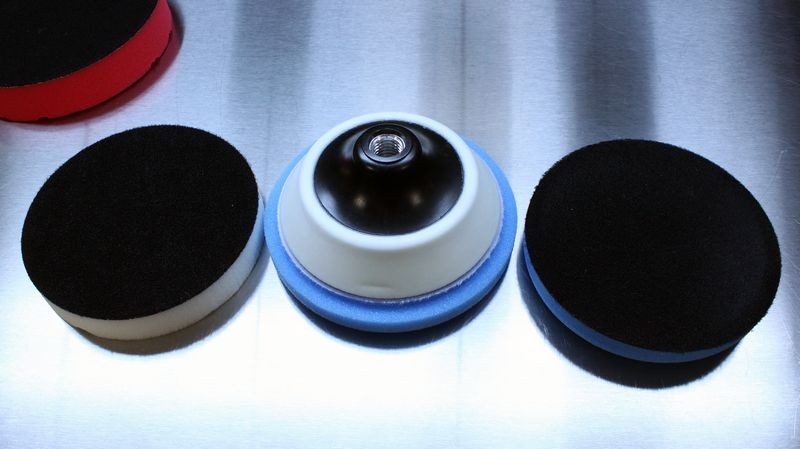
Flex-Foam Backing Plate on a 5.5" Blue Finishing Flat Pad

Flex-Foam Backing Plate on a 5.5" on a Super Soft Gold Jewelling 6" Pad



Meguiar's W66 Solo Backing Plate


M66 Flexible Backing Plate on a 7.5" DuroWool 100% Twisted Wool Cutting Pad


M66 Flexible Backing Plate on a 7" Kompressor Orange Light Cutting Pad

M66 Backing Plate on a 6.5" CCS Red Ultrasoft Finishing Pad
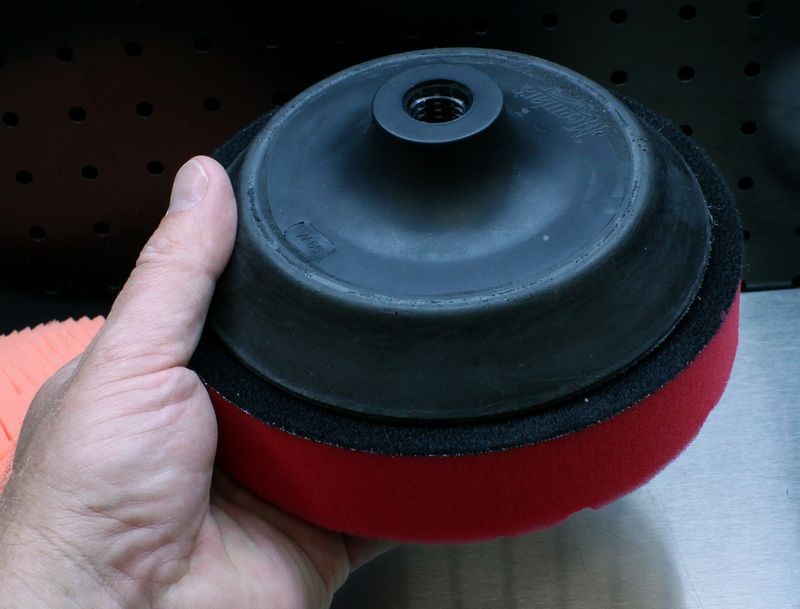
Note in this picture and all the above pictures the extra backing and or foam that sticks out past the outer edge of the backing plate. You want this extra material as a safety margin to help prevent running the outer edge of the backing plate into any painted areas, or around trim or other components like side view mirrors, rear wing spoilers, etc.
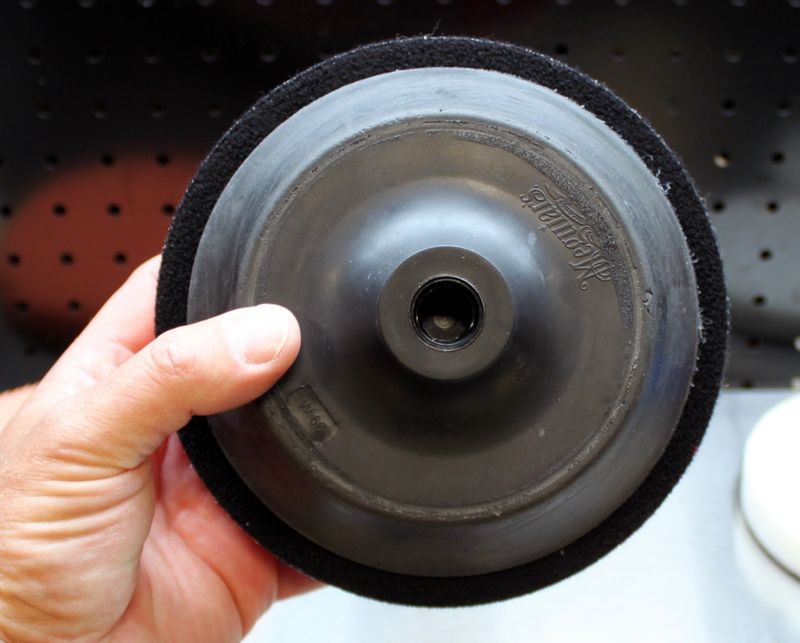
Both of these flexible backing plates are excellent backing plates to have in your tool chest to go along with your rotary buffer.
All of the above backing plates and pads work great with all the rotary buffers on Autogeek.net
Rotary Bufers

-
Re: New Flex PE14
From this thread,
Is it worth it to get the new Flex PE14-2-150?
Here's a re-write of an article I wrote about 3 years ago, I'm not finished with it yet so there's more to come but you might find some tips that will help you...
How to use a rotary buffer
There are a lot of different ways to approach working on any given car, usually you'll want to determine what you're working on, such as new paint, old paint, basecoat clearcoat or single stage paint. Then diagnose the condition of the paint and determine what it is you're going to try to correct, such as removing swirls, scratches, sanding marks, oxidation etc.,
After you have evaluated the paint you can then choose what you think will be the best products and pads for the job
Next you'll want to use the correct technique to apply the products and work them until you've removed all the defects you can to the best of your ability and within what's practical for the paint you're working on. Understand that some defects are too deep and you'll be better off and safer to learn to live with the deeper ones versus trying to remove them all the way and risk removing too much paint.
When you're first learning how to use a rotary buffer, it's a good idea to just tackle a single panel your first time. Considering you have to do the rotary buffer step and then after that a number of more steps until you get the paint up to the waxing step, just tackling a panel, like the hood of a car, is going to take some time to go from start to final wipe-off. So don't tackle an entire vehicle your first time out.
Also don't try to learn on something that's important to you, like a Black Viper, or whatever your pride and joy is, instead either work on an older car that no on will care if you make a mistake or spend a little time obtaining a hood off a car out of the wrecking yard.
Following the advice above, we recently worked on only one half of a panel, and from the time we started to the time we finished to clean, clay clean, polish and the wax and wipe-off took about one hour and that was just for one half of the hood. So start out slowly, and start out on something you can afford to make a mistake on. Then as you gain experience, skill and confidence, you'll be tackling entire cars in no time.
Here's what you do,
Gather your supplies
Get yourself a collection of wool and foam buffing pads, you'll also need some compounds and polishes formulated for use with rotary buffers, these are "Tools" for your tool chest.
You'll need plenty of clean, soft microfiber polishing cloths and a bonnet or two if you want to remove the wax by machine.
Misc Tools
Painters tape, tinfoil, Beach Towels, Bed sheets, Newspaper, Plastic Drop cloths, Plastic Bags... (Just some examples)
Work Clean
Always work clean, this means a clean car and a clean work environment. You don't want any dirt getting into any of the machine buffing processes as you will risk instilling swirls into the paint. Sweep the floor, this will prevent dirt and dust from being kicked into the air as you work around the car. You should at least start out clean, you're going to get dirty in the process.
Dress for success
Put some work clothes on including a soft cotton t-shirt that covers your waist line and you don't care if it gets splatter on it. Sometimes you'll find yourself leaning over a panel and your body touching the paint, have a soft cotton t-shirt to cover your pants so the waist of your paints, things like belt loops, snaps etc., don't come into contact with the paint, only the soft cotton t-shirt.
Also be careful so that you can avoid touch the paint by leaning on it but if you have to, then do everything you can not to instill any scratches. The bigger the car, the bigger the panel the better the odds you might have to "touch" the paint somewhere when you're leaning out to get the hard to reach areas. You can wear an apron but most of the time it's hard to find an apron that's as soft as an old cotton t-shirt.
Quote:
Knock out the top first
Here's a tip, if you think you're going to have to lean on the car to reach an area like the hood or roof, then knock out these areas first, from beginning to end and then tackle the side panels. This way you won't re-instill scuffs or scratches into panels that you've previously buffed.
I almost always knock out the roof on cars from the first step to the last step and then tackle the rest of the car.
Safety glasses are a good idea if you don't wear glasses. The rotary buffer does have a spinning head/pad on it and it could throw something into your eyeball.
Hearing protection is also a good idea as these machines are noisy. You probably don't need hearing protection for working on only one panel, but when you go to buff out an entire car you should have some type of ear protection.
Good shoes. Using the rotary buffer involves you legs, back, arms, shoulders, etc. You'll find that you'll use your legs/feet to anchor your stance while you control the machine. Again it's not that big of a deal if you're just working on just a singe panel but when the day comes and you start tackling entire cars, especially larger vehicles in bad condition where you're going to go around the vehicle 2-3 times with just the rotary buffer, if you don't have good shoes your feet and legs and even the rest of your body are going to pay a price as you work through the day. Something that encases your ankles like high-top tennis shoes work really well, (at least for me).
Prepare the car
Chose a car, wash it and then clay it if it needs it and only tackle one panel on one day to start with. Choose either the hood or the deck-lid, a horizontal panel.
Tip - Wash the day before
If possible, wash the vehicle the day before, that way it will be dry when you go to work on it. Rotary buffers can create an air current and pull water in body seams, cracks and crevices onto the panel as you're buffing.
Also, unless you or your customer has a Floor Lift, then if you can't bring the car up to you... you're going to need to lower yourself to the car in order to properly buff out the lower panels. You should be looking across from the panel as you buff on it, that means for the lower panels sitting your butt on the floor of the garage. It's a bad idea to try to buff out lower panels by bending over, this will stress your lower back. You can drop to one knee, or both knees, (have knee pads on), or use rolling stools, or milk crates, or foam cushion pads, whatever works for you but avoid bending over and running a rotary buffer.
Evaluate the condition of the finish
After washing and drying, inspect with your eyes and look to see what's wrong with the paint, does it have swirls and scratches. Is the finish horrific? As in really horribly swirls-out? Or just light swirls and scratches?
Use two kinds of light
It's a good idea to inspect the paint in at least two kinds of light, sunlight is very good at revealing swirls, florescent lights like many garages have are very good at revealing water spots, etchings and isolated deeper scratches and orange peel.
Use the least aggressive product to get the job done
With experience you can make a judgment call based upon the visual inspection of the paint you're about to work on to choose the appropriate product.
Synergistic Chemical Compatibility
In simple words, I tend to be a system guy, that is I will tend to use all products from a single manufacture using a system approach. Here's how this works...
The chemists that formulate the first step products, since they know what's in them, they are better able to formulate the follow-up or second step products so there's a synergistic chemical compatibility. Using one product designed to be used after the results of the previous product is a system approach.
If you're getting into using rotary buffers, then consider getting a collection of products from a single manufacture designed as a system approach for use with rotary buffers, this usually means products manufactured for the Professional side of this industry which includes products for body shops or the detailing industry. Here's a list of companies that offer system approaches for use with rotary buffers.
Menzerna
Pinnacle XMT
Optimum
Mothers
Meguiar's
Poorboys
3M
Perform a Test Spot
Map out a section on the car about 16" to 20" square or so and work the product against this area, apply a strip or bead of product about 6" to 8" long and pick up your bead using the 10 @ 10 Technique.
After you pick up your bead of product instantly hold the pad flat to trap the product between the face of the pad and the surface of the car and begin making slow, overlapping passes to the section. Like using a DA Polisher, you can make overlapping passes and go in two different directions to insure UMR, Uniform Material Removal. Work the buffer for about a minute, basically long enough to make two to three passes in two directions over this section. Don't buff to a dry buff.
Wipe of the excess residue and inspect.
Are the majority or all of the swirls and scratches gone? If yes you now know what product to use and how long to buff with it, as far as how to use the buffer that's going to come with practice. Start out working on the easy stuff, (large flat panels) and as you get more comfortable with the tool you can start tackling A-Pillars, B-Pillars, doors, fenders, etc.
If after you inspect the finish and most of the swirls and scratches are still there, then re-buff the area a second time, see of a second application of the same product using the same pad will get the job done, if not then it's likely you'll have to try a more aggressive product/pad combination.
In most cases, a medium aggressive polish and a polishing pad on a rotary buffer will at least remove the light or shallow defects and if this is the case then this could be an indicator that the paint is hard and/or the defects are deep but if you're just learning how to use the rotary buffer then it could also be that you're technique just isn't dialed-in enough for "you" to be effective with this combination. That will come with time and for now since you’re learning if you're seeing "better" results then when you started then continue over the rest of the panel.
As you gain experience, you can judge whether or not to start out with a wool cutting pad and a compound if the paint looks like it has a lot of deeper swirls, scratches and water spots. Balance the product and pad you use to the type of service you're offering and your customer is willing to pay for. See this article,
A few tips on starting a part-time detailing business
Before you continue however let's tape-off and cover up.
Tape-off and cover up
Even though the idea is to be very good at what you do so that you don't have splatter onto trim or into cracks and crevices, even the best can make these mistakes, so you need to make a judgment call as to whether you want to tape off and cover up trim, emblems, cracks and crevices or hard sharp body lines where the paint might be thin like the edge or corner edge of a hood.
The Beach Towel Tip
Another trick to help you avoid splatter is to have plenty of pads on hand so that if the pad you're using becomes to wet with product you can simply switch to a clean dry pad. This tends to improve buffing performance and reduce the potential for any splatter. Generally speaking, more pads are better no matter what tool you're using.
The First Step Process – The Cutting or Cleaning Step
once you have your first step process figured out and you have taped-off or covered up anything you want to protect, continue to buff the panel you did your test spot on working each section of the panel equally. In most cases, you'll want to carve out sections of large panels and only buff sections or quadrants of the entire panel during the first step. Smaller panels can be buffed in one or two sections. As I always say...
"Let the panel be your guide"
The most important part of any detail job is the first cutting or cleaning step. It is this step that will determine your end-results. If you don't remove the defects in the first step, then you're going to be seeing them at the end of the job. So invest your time into the first step.
Work each quadrant of the panel you're working on carefully, thoroughly and sufficiently to equally remove enough paint over the entire section to remove the defects to the level you're comfortable with. Understand not all defects can be removed without the risk of removing too much paint and going through the clear on a clear coat paint job and exposing the color coat, or going through the color coat of a single stage paint job and exposing primer.
After working each section, wipe off and remove any excess product. Never apply fresh product to spent product it will dilute and adulterate the fresh product. Always work clean.
After you have worked each quadrant or section over the entire panel, then do what's called a few "Cover Passes", this is where you use the rotary buffer to now buff the entire panel to more or less tie all your work together, that is to give the finish a uniform, level surface with equality in appearance over the entire panel. In most cases the paint is going to have light swirls or haze after this step but that's okay as the next step will remove most of these.
The Second Step Process - The Polishing Step
At this step you can either make another pass using a less aggressive pad and product on the rotary buffer or you can try to move to a machine that oscillates instead of rotates for example the Porter Cable 7424XP, the Griot's Garage ROP, the Cyclo or the Flex 3401.
If your goal is a swirl free finish then you need to find out if the DA Polisher will remove any remaining swirls from your First Step Process or if you need to use a rotary buffer to remove these and then go to the dual action polisher. What determines what you have to do is usually the paint hardness or softness, i.e. polishabilty and of course your ability as a craftsman in the art of polishing paint. Polishability you can't control, but your skill level you can with experience.
At this point you could do another Test Spot, usually you would try to use the DA Polisher and a light cleaner/polish to see if you can remove any remaining swirls and produce a finish perfect for applying your choice of LSP to.
Another option is to only use the rotary buffer for all the correction steps and the final polishing steps but this takes a little practice and not all paints are able to be polished swirl-free using only a rotary buffer.
The only way to really tell is to buff out a horizontal panel like the hood or trunk lid, something you can look down on and then after making doing your last rotary buffer step, strip the paint by wiping with IPA, Mineral Spirits or washing it with a strong detergent wash and then move the car into bright, overhead sunlight. Bright sunlight is very good at revealing even the faintest tale-tale signs of rotary buffer trails also called holograms. If you don't do this kind of test, then how will you know if you truly left behind a 100% swirl free finish?
The problem with this kind of test is that it takes time to do, but if you have the time then go for it. Also, washing and/or wiping with any kind of solvent creates the potential for re-instilling swirls and scratches, just be aware of this as after your inspection you may have to re-polish the panel again.
Once you confirm you are able to create a 100% swirl free finish on the paint system you're buffing on using only a rotary buffer, then simply duplicate that procedure over the rest of the car and as long as no panel has been repaired and thus has different paint on it, then you should have uniform results over the entire car.
If you want to ensure you're not leaving behind any rotary buffer swirls or holograms, and you don't want to wash or strip the panel after buffing, then use a DA Polisher for the final finish polishing step.
By changing the action of the tool from direct drive rotating action to an oscillating action, you will ensure that you've removed any rotary buffer swirls. Of course, now you'll need to make sure you're not leaving any micro-marring, also called Tick Marks or DA Hazing. This is easy enough to check though as it will show up in a small area it's best to check for rotary buffer swirls over a larger panel or section of a panel.
Micro-marring can be avoided by using a high quality finishing polish wit a clean, soft foam finishing pads and then doing a Test Spot and then striping the test spot and inspecting using a Swirl Finder Light
After you decide upon a tool, pad and product to remove the remaining swirls and polish the surface to a smooth, high gloss, (take the paint to its maximum potential), then repeat the above steps of slicing each panel of the vehicle up into sections and working your product over each section thoroughly. Then wipe the entire panel clean and make some Cover Passes. Next wipe the panel clean for the next step.
The Third Step Process – The Protection or Waxing Step
Use your DA Polisher to apply the LSP of your choice usually using a finishing pad. Set your speed setting at around the 4.0 to 5.0 speed setting and apply your LSP over the entire panel making, slow, methodical passes. Try to go over each square inch 2-3 times to allow the oscillating foam pad to really do a good job of pushing the wax or paint sealant into all the microscopic surface imperfection, pockets and pores, hills and valleys, and interstices. Leave a thin, uniform layer over the entire surface.
If you're using a WOWO product then wipe it off immediately.
If you're using a product that needs to dry, then wait till the layer of product swipes clear before removing. Take a break while the wax or paint sealant dries so you're refreshed before wiping off the wax or paint sealant.
At this point in the process under the wax or paint sealant should be a show car finish or something very close to it, so you don't want to instill any swirls or scratches when you wipe the dried product off and besides using clean, soft microfiber towels, you want to be physically refreshed so you can be careful with your wiping actions. Buffing out an entire car using a rotary buffer is a lot of work and by the time you get to wiping the wax off you're going to be tired.
Swipe Test
After allowing the wax to fully dry for anywhere from 10 minutes to longer, how long depends upon temperature, humidity and how thin or thick your layer of wax is, but after some time has gone by test the wax to see if it's dry by performing the Swipe Test, that is to take your clean finger and give the waxed area a brisk swipe.
After you do this inspect the swiped area, it the wax is dry and ready to remove the swiped area will be clear and glossy. If so, the remove the wax. If the area you swiped is smeary, then wait for more time to go by and maybe evaluate how thick the coating of waxy you applied is, perhaps you applying your wax to thick and this is why it's taking a long time to fully dry? In most cases, in average temperatures and humidity, a coating of wax or paint sealant will fully dry in about 15 to 20 minutes. Always check the manufactures recommendations and follow these as the manufacture knows their product best.
Remove the wax
Once you determine the wax has fully dried, then remove the wax by hand or machine using a soft, clean microfiber polishing cloth.
De-Tape
Remove any tape or other items you used to cover and protect areas or components on the car.
Wipe down
Remove any remaining residue and inspect.
Sometimes moving the car into a different light setting will show you places with wax you missed. Sometimes getting another set of eyes to help you to inspect will help you to insure all wax and residue is removed.
Put your tools away... you're done for the day...
Summary...
When you're learning to use the rotary buffer, don't try to tackle an entire car in one day, just tackle a single panel, or even half of a single panel, and get some experience with the different pads and chemicals as well as how to hold and master the tool.
It's also a very good idea to never learn to use a rotary buffer on something that's important to you, like a Black Viper!
Find a less important car, something that no one will care if you make a mistake on or go to a salvage yard or a body shop and get a hood or trunk lid to practice on. Anchor it to a couple of saw horses or go to a PBE store and get an panel stand.
Of course there's more to learning how to use a rotary buffer but the above should provide you with a good starting point. Practice makes perfect. Experimenting with different types of pads and products with different techniques will enable you to hone your skills and find a system approach that works best for you.

-
Re: New Flex PE14
From this thread...
How do you stay away from holograms?
 Originally Posted by MaximumMD

So since it's hard to stay away from holograms with a rotary, I think I found how to quickly correct paint in bad shape and not finish with holograms. Start with the rotary with a wool or hard foam pad, and then finish with a DA polish, PC, GG, or whatever you use.
I haven't tried it yet. Figure I would share my idea before I tried it myself. Just wondering if anyone else have tried this before.
Post #8
Just to chime in...
The best way to see if you are in fact leaving behind a rotary buffer swirl or hologram free finish is you have to chemically strip the paint and then inspect the paint under bright light like overhead sun.
Also, this is best done on black paint as black shows everything. It's easy to buff on a white, or silver metallic, or any light color and not see faint swirls left by the rotating action of the pad on a rotary buffer.
Because 'fine' or shallow swirls can be hard to see, the ultimate way to inspect would be to test yourself on a large flat panel like the hood of a car, (a car hood that's large and flat, harder to find with modern, small cars), and then after your last step, wipe the paint down with IPA, or MS or do a Dawn wash.
Next, move the car into full on sun when the sun is bright and directly over head.
Now move around the car placing the sun into different locations on the hood and inspect for a 100% swirl free finish.
- Inspecting without chemically stripping will not prove you left a swirl free finish.
- Inspecting without using really good light, like bright overhead sunlight won't prove you've left a 100% swirl free finish.
I never see people doing this step or even talking about it let alone proving it and in the process of proving, sharing the proving process and results process.
I never see people proving their work with this step and posting real pictures of the swirl free finish in full sun after chemically stripping. This step means taking longer to buff out any car and during the chemical stripping process you risk marring the paint and if you wash with Dawn, then you get the car all wet again, this means water in the cracks and crevices that won't dry like a flat panel so when you bring the car back inside to finish buffing it out, now the air current a rotating buffing pad creates will draw the water in the cracks and crevices into the buffing cycle.
It's a lot more complicated to 100% prove to yourself or anyone else that you are in fact leaving a 100% swirl free finish. I see people make the claim all the time but that's just their claim. As someone that has done a lot of testing on black paint and buffed thousands of cars with a rotary buffer, it's a lot harder to do than most people think and the ONLY way to know that you have IN FACT left behind a 100% swirl-free finish is to chemically strip a dark or black finish after your last rotary buffer step, move the car into bright sunlight and then inspect.
Other than that... how would you really know?
Instead of doing all of the above, simply finishing out by "Changing the Action of the Tool", in other words, by changing over to a DA Polisher and re-polishing every square inch of the car, you "ensure" that you've left a 100% swirl free finish and you've never worked backwards in the process.
Post #9
Here's an example of moving your work on a black panel into direct, overhead sunlight to check your work. Anyone reading this attend this class and remember this or watch the "Live Feed" ?
http://www.autogeekonline.net/forum/...2-class-2.html



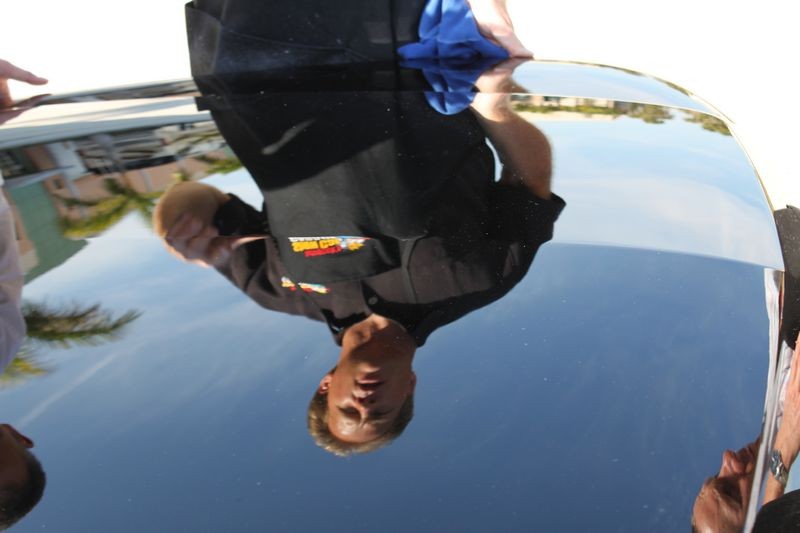




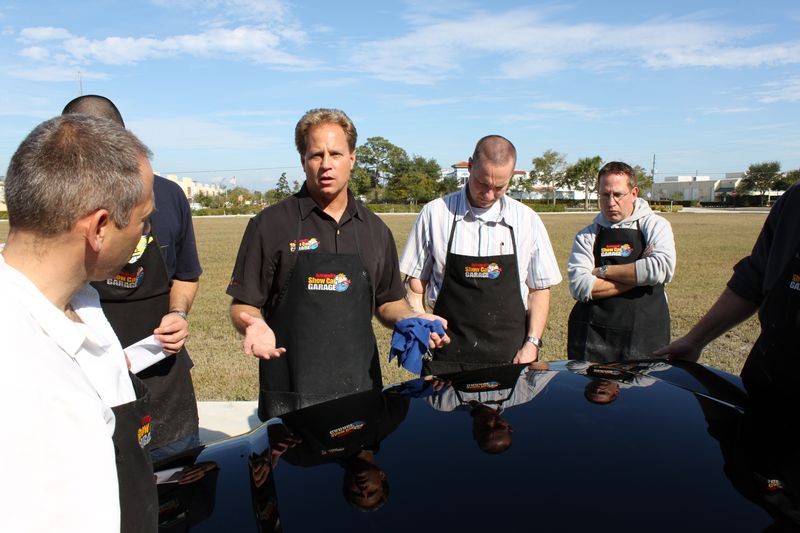

-
Re: New Flex PE14
That ought to give some ideas and information to chew on...
Try to make it to one of our classes here in Stuart, Florida...
Sign-up for our next Hand-On Detailing Classes!
Detailing 101 Class - Machine Polishing - Saturday, May 14th, 2011
Detailing 102 - Wetsanding, Cutting and Buffing for a Show Car Finish - Sunday May 15th, 2011
Or call 1-800-869-3011 to sign-up over the phone
Note: You must have attended Detailing 101 before you can take Detailing 102
Hands-on Classes with Mike Phillips
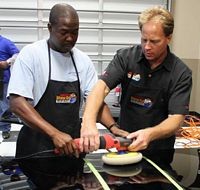 
Info Threads - Post Questions or Comments:
Detailing 101
Detailing 102
Live Broadcast
By signing up for a class you agree to sign a Video Release Form upon arriving to the classroom for the possibility that these classes will be streamed live over the Internet and/or recorded for later use. See you here!
Pictures & Comments from January 29th Detailing 101 Class
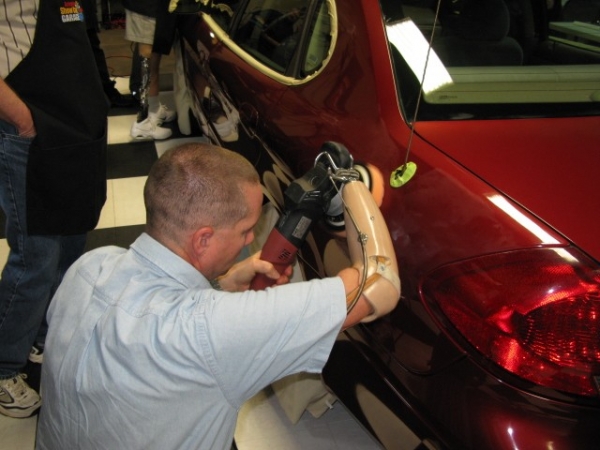
Pictures & Comments from January 30th Detailing 102 Class

Do you want to attend a Detailing Class?
Do you want to learn the art of polishing paint to remove swirls, scratches, water spots and even orange peel? Then send me an e-mail...
If you want to be notified when the next Detailing 101 and 102 classes are scheduled, then please send me an e-mail, (not a Private Message), with the subject: Class Request to Mike.Phillips@Autogeek.net

-
Super Member

Re: New Flex PE14
This is inspiring!!

-
Re: New Flex PE14
 Originally Posted by superior_shine

This is inspiring!!

I agree Joe,
Not only did he have a great attitude towards life he worked these machine, all of them, like a Pro...
Very inspiring....

-
Re: New Flex PE14
Thank you guys so much for all this information!!! I feel more confident already and I have not even used this machine yet! I know if I have any more questions there is someone out there that knows the answer. Thank you guys so much again. 
-
Re: New Flex PE14 - How to use ONLY a rotary buffer to finish out hologram free?
Something I wrote months after replying to this thread that I want to tag on...
Hologram Free with a Rotary Buffer

Similar Threads
-
By Mike Phillips in forum Auto Detailing 101
Replies: 52
Last Post: 07-09-2016, 11:43 PM
-
By Mike Phillips in forum How to articles
Replies: 17
Last Post: 01-21-2015, 12:08 AM
-
By ShineTimeDetail in forum Auto Detailing 101
Replies: 23
Last Post: 07-16-2012, 10:56 PM
-
By Mike Phillips in forum Autogeek on Velocity Channel TV
Replies: 4
Last Post: 03-28-2012, 11:47 AM
-
By Mike Phillips in forum How to articles
Replies: 35
Last Post: 11-24-2010, 05:38 PM
 Members who have read this thread: 0
Members who have read this thread: 0
There are no members to list at the moment.
 Posting Permissions
Posting Permissions
- You may not post new threads
- You may not post replies
- You may not post attachments
- You may not edit your posts
-
Forum Rules
|
| S |
M |
T |
W |
T |
F |
S |
| 31 |
1
|
2
|
3
|
4
|
5
|
6
|
|
7
|
8
|
9
|
10
|
11
|
12
|
13
|
|
14
|
15
|
16
|
17
|
18
|
19
|
20
|
|
21
|
22
|
23
|
24
|
25
|
26
|
27
|
|
28
|
29
|
30
| 1 | 2 | 3 | 4 |
|













 Thanks:
Thanks:  Likes:
Likes:  Dislikes:
Dislikes: 

 Reply With Quote
Reply With Quote






























Bookmarks